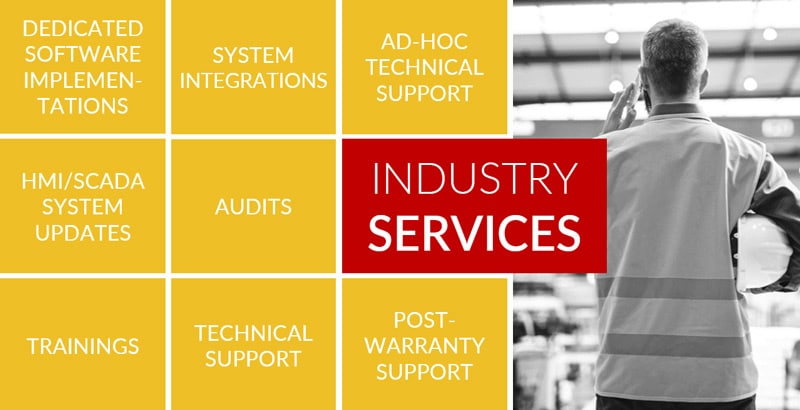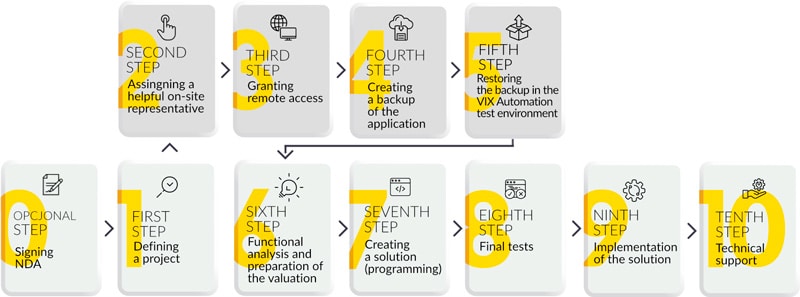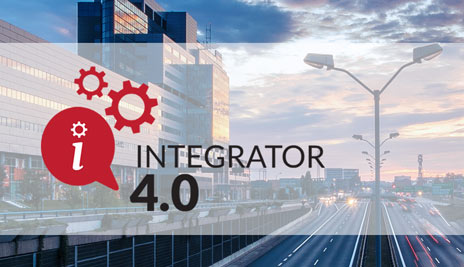Remote deployment experts
The modern world allows us to do many things without being physically present in a specific and fixed place. We deal with banking, official and educational issues remotely, and above all, we work. The COVID-19 pandemic has accelerated the revolution in remote work, and the number of tools supporting physical “non-being” in a specific location is dizzying. However, is it possible to implement such a complicated and complex system as software for an industrial plant without the physical presence of the implementer? Yes of course! We have been working this way for several years!
So what do you need to do to be able to work remotely? What are the steps?
Industry services remotely
So let’s start at the end: what services can we provide without a physical presence at your facility? In fact – each! With appropriate technical resources (also on your side), we can conduct training, audit, but also integrate systems already operating in your plant, update or comprehensively implement a new solution. What’s more, technical support (both warranty and post-warranty) can also be provided remotely.

Software production process
Each project we implement (regardless of the way it is implemented) goes through a similar path. It is presented in several steps as follows:
0. NDA signing (optional)
1. Defining the project
2. Functional analysis and preparation of the valuation
3. Creating a solution (programming works)
4. Final tests
5. Implementation of the solution
6. Technical support

What should be taken care of in a remote project?
Often, the “zero” point is the signing of non-disclosure agreements (NDA) between the contractor and service provider, and the ordering party. This is not a necessary point of course, but it is often required, important not only in the case of remote deployments.
One of the first steps is to ensure that the customer’s IT department assigns remote access to the system. Experience tells us that it is often a very long and arduous process, often requiring the involvement of third parties who are not involved in the implementation works themselves. This is not surprising, the action of granting access often involves IT specialists who meticulously take care of cybersecurity procedures and this is an essential element of the process. In the next step, the application is backed up – which is also to ensure the security of the implementation and the entire installation.
Such a downloaded archive is used by our system engineers to define the scope of the project and to define any additional works with the Employer, but above all it is used for precise valuation of the scope of works.
One of the most important components of a successful remote deployment is efficient communication. Implementations cannot proceed without informing each other about the work undertaken and changes that have occurred since the last organizational update. It is important to properly and unambiguously mark roles in the project, and accepting partial works allows for more agile implementation management.
Before the final implementation, final tests are naturally necessary – and after successful implementation, the acceptance of the project by the ordering party. As an experienced implementation company, we also provide warranty services, and later post-warranty support, which we can also provide remotely.

A helping hand
However, remote connection is not everything. In remote projects, mutual trust and playing to a common goal are very important. However, it is impossible to completely disable the human factor on the part of the ordering party. Situations such as computer reset or prosaic “pulling out the cable” happen from time to time. Don’t worry – they’re not as common as you think! We try to minimize it!
Remote work solutions
The 21st century is the century of remote work, solutions supporting remote work are multiplying in the eyes! From classic VPNs, TeamViewer, remote desktops to more advanced tools. All this with appropriate tools for communication and remote presentations. Our engineers are fluent in almost all of them!
Pros and cons
One of the biggest advantages of remote implementation is the lack of travel, and thus the elimination of transport and logistics costs. It is no secret that this is one of the main reasons for remote implementations – and T&L costs noticeably increase the costs of implementation at the end customer. In addition, there is not always a hotel base in the vicinity of the plant, which allows for easy transport to the plant. From our experience, as well as that of our partners, we know that not every location is a perfect place for a business trip, like establishments in countries with high travel risk. The risk resulting from such on-site works is also included in the final implementation cost.
Remote work also allows you to implement small, cosmetic fixes at a rapid pace. A traditional on-site implementation often involves several visits during which all comments, errors, and oversights should be collected and passed on to the implementer. In the case of remote “visits”, an e-mail is enough for the implementation specialist to make the appropriate correction.
Having data backups and having remote access to the systems, we can conduct faster software tests, catch more errors before the implementation itself. This shortens the implementation time itself, and also reduces or completely eliminates system downtime.
Remote “presence” at the customer’s site also ensures faster response times to incidents and errors, and faster technical service.
For remote implementation to take place without any obstacles, however, we recommend the presence of the client’s employee at the plant during the final stages, who will be able to take care of, for example, the hardware part of the implementation (often it comes down to physically switching on the equipment and attaching the appropriate cables).
We have over a dozen remote implementations in Poland, as well as in Europe. I will be happy to tell you where we have already been virtually!

Paweł Czepiel
Head of Sales
It is also worth highlighting one of the main disadvantages of remote implementation – when working over the Internet, we rely on the performance of links, also within the company – and their throughput varies. There is a risk of losing connection during such a deployment, which may slow things down a bit. There may also be technical difficulties, such as not having more monitors to display a large format application.
Once again, let us remind you how important communication is during such a project – you cannot remain silent about any aspect of the implementation, because it will come back to us like a boomerang in its subsequent stages. Working with the client, we always make sure that the delivered software exceeds their expectations, which is why it is so important to correctly communicate your needs and necessary changes. Every good implementation starts with a good conversation, opening your eyes (and ears) wide helps in efficient work.


